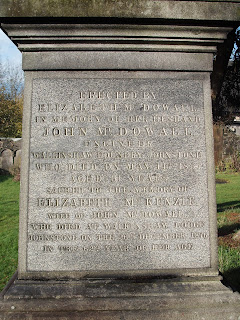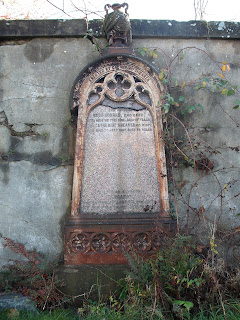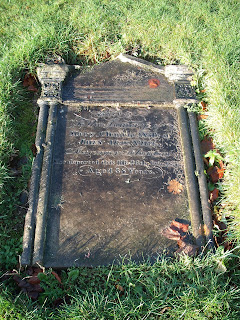Physically sandwiched in between the parish localities covered by the last two posts (i.e. Lochwinnoch and Johnstone) Kilbarchan, like Lochwinnoch, has territorial origins in the Early Historic period and in another alleged 'Celtic' saint, here one St Bearchan.
Nothing of pre-1700 church structures on the site survive, with the present parish church hall being in fact a replacement kirk of 1724 - the large in-use flanking Gothic-styled church, meanwhile, representing a subsequent replacement of 1900-01. Now termed 'Kilbarchan West Parish Church', visible stones - for the most part worn flatstones - within the surrounding graveyard clearly pre-date the nearby 'East Church' cemetery.
Above: wall plaques to several ministers from Robert Stirling (incumbent 1593-1603) to Robert Douglas who died in the 43rd year of his ministry here in 1846.
Above: large granite Celtic cross memorial to James Stevenson of Auchenames (d.1849) his successive wives Margaret Glen (d.1815 in her early 20s) and Mary Jackson (d.1878) and descendants.
Imposing Classical-styled pediment monument, principally to Peter Cochrane of Clippens.
Above: view from road showing characteristic crow-stepped gable-front (compare 'Auld Simon' stump preserved at contemporary Lochwinnoch parish church) and (later) incongruously attached Baroque-like tower with balustraded parapet.

An early barn-like Seceder Church at nearby Burntshields was - in terms of the main local dissenting outlet - soon superseded by the building now recognised as the East Parish Church - originally a Relief Church congregation. The date '1787' above the 19th century vestry extension fronting the main church refers to the original foundation - with the main 'box' church with its characteristic Scots 'hipped' roof completed by 1790. The graveyard around the old Relief Kirk is extensive, with stones not only commemorating ministers and members of the congregation but parishioners in general including prominent local gentry whose sympathies would rarely have been with religious dissenters like the Relief.
Entry through pend to the old Relief (in turn U.P., U.F) now 'East' parish church.
Above: within a burial enclosure a plaque commemorates the first minister, the Rev. John Maclaren (d.1808) and his wife. Below: on the south-east boundary wall, this granite memorial blending Classical styles (resembling the work of contemporary architect Alexander' Greek' Thomson - perhaps more than coincidentally a member of the same denomination) memorialises William Speirs (d.1877), his wife Janet Lyle (d.1875) and their children - four of whom died in infancy.
Another imposing and unusual monument, comprising an ornate obelisk rising above two (joined in one) pedestal tombs. One plaque records Archibald Crawford (like Speirs a renowned local name) d.1879, his wife Isabella Barr d.1864; the other (image right-hand side) is completely worn, but carries the name Dr. M.M. Gibson above, and a verse beneath alluding to yet more children to have died in infancy (presumably those of Dr Gibson and his wife):
Few passing years were theirs sweet babes.
Few summers saw their earthly bloom.
Soon, soon their grieving parents laid
Their lovely Infants in the tomb.
Eternity, for time is given.
Eternal joys, for transient pain.
For earth, a happy home in Heaven.
With Jesus now our children reign(s).
Above: large burial enclosure to Alexander Cunninghame of Craigends and Walkinshaw d.1866 (now demolished mansion houses in the area), his wife Jane McHardy (d.1864) and son Alexander, who died aged 2; below - to the side, the fallen pediment formerly crowning the memorial.
Below: on the west wall, a railed enclosure with memorial within to the Napiers of Milliken (another now-demolished gentry seat) - including to William Napier killed fighting against the "rebels" during Canada's little known 'Fenian Rebellion' of 1866. Behind the memorial (across-road): the gable-front of a former dissenting church.
Above: large, quite remarkable monument of Gothic design. Beneath a funerary urn a worn, illegible, plaque is flanked by one of two surviving pinnacled buttresses - the other having collapsed in pieces to the front.
Reading/further information: as with most historic parishes - again the Old and New Statistical Accounts (available on-line), which feature information on principal local families now represented within the two graveyards featured
Also: (1) Burgess, Moira Discover Kilbarchan, Bridge of Weir and Houston (Renfrew District Council, 1995) (2) Hood, John Old Kilbarchan (Stenlake, 2010).
.




































